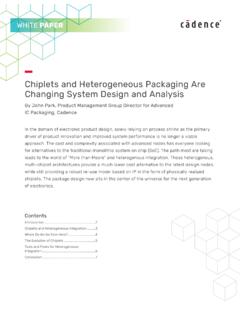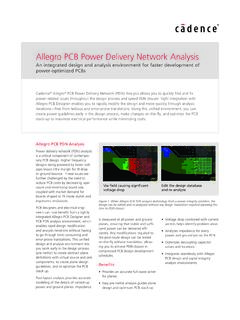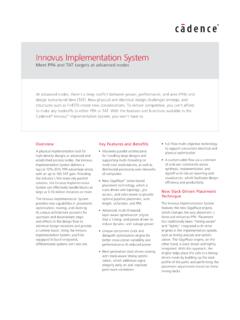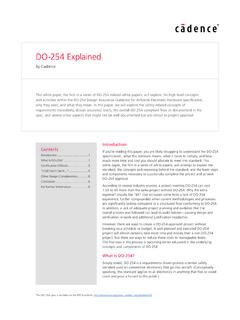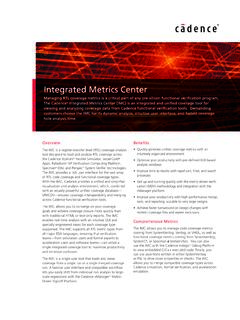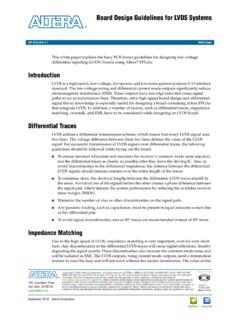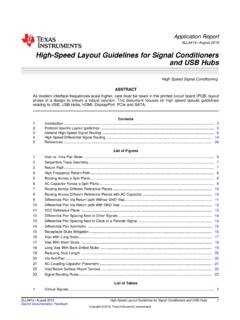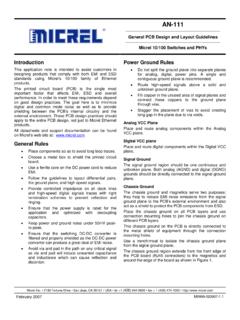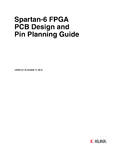Transcription of Routing DDR4 Interfaces Quickly and Efficiently
1 Michael Catrambone, Sr. Principal Product Engineer, Allegro PCB ProductsRouting DDR4 Interfaces Quickly and Efficiently2 2016 Cadence design Systems, Inc. All rights West 2016 Routing DDR4 Interfaces Quickly and Efficiently Today s challenges Do more with less and deliver on time! Time to market with product meeting ALL performance and design requirements Increasing design complexities with advanced Interfaces like XFI, XGMII, XAUI, DDR4, PCI Express (PCIe ) Requires an advanced set of electrical and physical constraints The days of connecting the dots are long gone This paper will: Provide an overview of DDR4 memory Interfaces including topologies and constraints that need to be adhered to in order to meet timing requirements Discuss new techniques designed to accelerate Routing and tuning of high-speed signals Quickly and Efficiently These techniques can be applied to component breakout, point-to-point Routing , and tuning of signalsPCB Challenges as Interface Speeds Increase3 2016 Cadence design Systems, Inc.
2 All rights West 2016 Routing DDR4 Interfaces Quickly and Efficiently Building a stable PCB design foundation Careful planning of component placement and reserving space for pin escape (fanout) Pin escape with interconnect topologies, Routing , and any possible testing requirements in mind Split plane planning during placement stage too late once board is routed (power integrity issues) Route flow planning between devices is critical to the success of any design Most direct route path to accommodate all Routing including maintaining all design clearances Quick and precise component Routing escape optimizing the order on both sides of the bus Effective timing closure with goal guidance using interactive and automatic means Ultimately, today s designs dictate that you must be thinking about Routing critical connections in earlier design stages while allocating adequate space to meet design /matching requirements and Routing topologiesDeveloping an Action Plan4 2016 Cadence design Systems, Inc.
3 All rights West 2016 Routing DDR4 Interfaces Quickly and EfficientlyDDR4 Memory Interfaces Overview5 2016 Cadence design Systems, Inc. All rights West 2016 Routing DDR4 Interfaces Quickly and EfficientlyDDR4 Functional Groups (Controller)DataData Mask orData Bus InversionData Strobe(differential _P& _N)Address and CommandControlDifferential ClockDDR4 Memory Interfaces Overview Functional group to route group mappingRoute Groups(Memory)BYTELANE0 BYTELANE1 BTYELANE2 BYTELANE3 BYTELANEnAddress and CommandControlDifferential ClockDQ[7:0], DQ[15:8], DQ[16:23],DQ[31:25], ..DM0/DBI0, DM1/DBI1, DM2/DBI2, DM3/DBI3, ..DQS0, DQS1, DQS2, DQS3, ..CS, C0, C1, C2, ODT, CKEA[17:0],BA[2:0]/BG[2:0],ACT,BC,CAS,RA S,PAR,WECK_P, CK_N6 2016 Cadence design Systems, Inc.
4 All rights West 2016 Routing DDR4 Interfaces Quickly and Efficiently Typical data bus structure:BYTELANE0DQ[7:0],DM0/DBI0, DQS_P0, DQS_N0 BYTELANE1DQ[15:8],DM1/DBI1, DQS_P1, DQS_N1 BYTELANE2DQ[23:16],DM2/DBI2, DQS_P2, DQS_N2 BYTELANE3DQ[31:24],DM3/DBI3, DQS_P3, DQS_N3 BYTELANEnDQ[<8bits>],DMn/DBIn, DQS_Pn, DQS_Nn Data bytelane members should be routed on the same layer Address/command/control/differential clocks should be routed on the same layer, but if space issues arise they can be routed on different layers Adjacent layers or layers referencing the same plane layer are preferred Address/command/control/differential clocks route topology Routed using a daisy chain (fly-by) topology.
5 Route from controller starting with Chip 0 thru Chip n Routing in order by bytelane numbers Chip 0 is the lower data bit (Bytelane0)/Chip n is the upper data bit (Bytelane3)DDR4 Memory Interfaces Overview General design requirements7 2016 Cadence design Systems, Inc. All rights West 2016 Routing DDR4 Interfaces Quickly and EfficientlyDDR4 SDRAM 0 Address/Command/ControlDDR4 Memory Interfaces Overview Bus topologies On-board SDRAM Data bus termination Series resistor termination can be used when point-to-point connection is in 2 to range Resistors located at center of transmission line DRAM termination with direct connect using on-die termination (ODT) Better signal quality and lower cost compared to using series resistor termination Clock termination 100 differential terminator at last SDRAM device in chainDDR4 SDRAM 1 DDR4 SDRAM 2 DDR4 SDRAM 3 Differential ClocksProcessor (Controller)
6 100 VTTData Bytelane 1 Data Bytelane 0 Data Bytelane 2 Data Bytelane 38 2016 Cadence design Systems, Inc. All rights West 2016 Routing DDR4 Interfaces Quickly and EfficientlyDDR4 Memory Interfaces Overview Bus topologies On-board two-UDIMM 1-cycle timing (1T) has two sets of address/command/control, driven by memory controller, connecting to each connector, as shown 2-cycle timing (2T) has one set of address/command/control connecting to both connectors Data bus is a point-to -point interface dedicated to one UDIMM module One UDIMM per memory channel VTT termination resistors are not required on main board as they are built into DDR4 modules Two differential clocks per UDIMMD ifferential ClockAddress/Command/ControlAddress/Comm and/ControlDifferential ClockVTTVTTVTTVTTVTTVTTData Bytelane (5)Data Bytelane (5)Differential ClockDifferential ClockData Bytelane (4)Data Bytelane (4)Processor (Controller)9 2016 Cadence design Systems, Inc.
7 All rights West 2016 Routing DDR4 Interfaces Quickly and EfficientlyDDR4 Electrical design Rules10 2016 Cadence design Systems, Inc. All rights West 2016 Routing DDR4 Interfaces Quickly and Efficiently Relative propagation delay Data bytelane 1 5milsbetween all members inside of bytelane Address/command/control 100 200mils between controller to first memory IC 10 20mils between memory ICs Propagation delay Normally not constraint controlled as it is driven by placement of memory ICs, which should be placed as close to controller as possible, normally between 1500 1750mils from controller to first memory IC and 650 750mils between memory ICs Differential phase tolerance 1 5milsfor all data strobe and clock differential pairs Disclaimer.
8 design rules above are for reference only and should be treated as such only tried and true way to determine interface design rules is with pre-/post-route simulationsDDR4 design RulesElectrical constraint targets11 2016 Cadence design Systems, Inc. All rights West 2016 Routing DDR4 Interfaces Quickly and Efficiently Impedance requirements Single-ended target = 50 60 Differential-pair target = 100 120 design stack-up considerations All Routing should have a solid reference plane to provide a low-impedance path for return currents Never route traces over splits or voids in the plane, including via voids. Entire data bytelane should be routed on the same layer, including data mask and data strobe differential pairs To avoid any possible crosstalk between layers, develop a stack-up that utilizes strip-line Routing layers for critical Routing vs.
9 Dual strip-line To minimize any via stub effects, route all connections on the furthest layer opposite the memory ICsDDR4 design RulesImpedance/ design stack-upStriplineDual StriplinesReference PlaneSignal LayerReference PlaneSignal LayerReference PlaneSignal LayerReference PlaneSignal LayerReference PlaneSignal LayerSignal LayerReference PlaneReference PlaneSignal LayerSignal LayerReference Plane12 2016 Cadence design Systems, Inc. All rights West 2016 Routing DDR4 Interfaces Quickly and EfficientlyInterconnect Topologies Daisy-Chain Routing Address/command/control routing13 2016 Cadence design Systems, Inc. All rights West 2016 Routing DDR4 Interfaces Quickly and EfficientlyInterconnect Topologies Point to PointData bytelane Routing /differential pair routing14 2016 Cadence design Systems, Inc.
10 All rights West 2016 Routing DDR4 Interfaces Quickly and Efficiently Careful planning of memory chips or DIMM connectors placement to allow best possible path for Routing Reserve space for pin escape (fanout), termination resistors as well as termination power supplies Locate memory chips to allow address/command/control/differential clock daisy-chain (fly-by) Routing , starting at controller, then connecting to lowest data bit chip first (Bytelane0), progressing up bytelane numbers, and ending at highest data bit chip Approximate spacing between memory chips should be no less than 200mils to allow matching outside of via/BGA field of devicesPlacement TechniquesComponent placement15 2016 Cadence design Systems, Inc.


